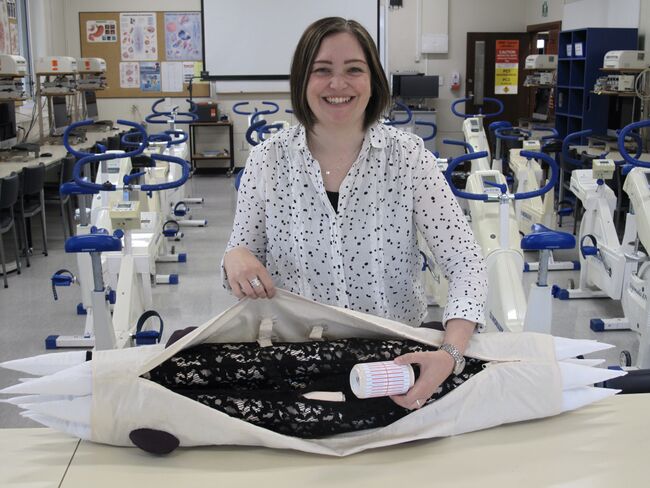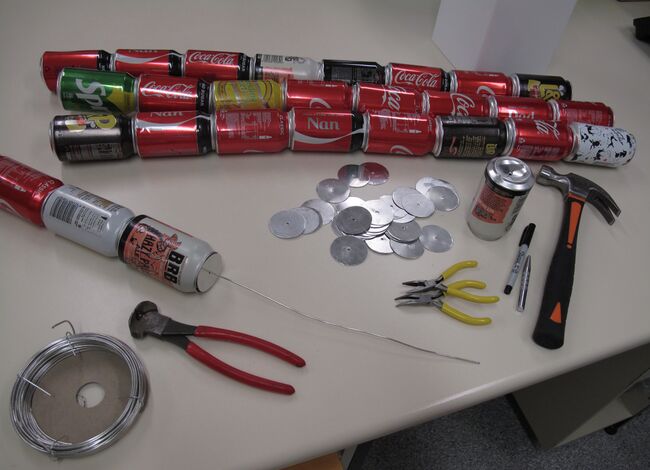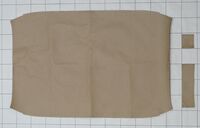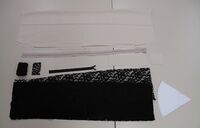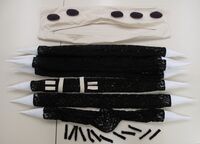Skeletal Muscle Fibre: Difference between revisions
No edit summary |
No edit summary |
||
| (One intermediate revision by one other user not shown) | |||
| Line 2: | Line 2: | ||
TanyaHero.JPG| | TanyaHero.JPG| | ||
</gallery> | </gallery> | ||
This schematic model was developed to help first year health science students understand the relationships between sarcomeres, myofibrils, sarcolemma, T-tubules, and sarcoplasmic reticulum, as well as muscle cell nuclei and the collagen which makes up tendon. The students realise that the structure of a skeletal muscle fibre is simpler than they imagine from looking at textbooks and easier to remember. | This schematic model was developed to help first year health science students understand the relationships between sarcomeres, myofibrils, sarcolemma, T-tubules, and sarcoplasmic reticulum, as well as muscle cell nuclei and the collagen which makes up tendon. The students realise that the structure of a skeletal muscle fibre is simpler than they imagine from looking at textbooks and easier to remember. | ||
| Line 14: | Line 13: | ||
Most of the cans were wired together into rows of eight, using galvanised 14-gauge wire (e.g., a 20-meter roll), and custom-made washers cut from 0.5mm thick aluminium sheeting (e.g., a piece 300mm x 900mm). The last set of eight cans was divided into a single can and a set of three and a set of four. The sets of three and four were wired together in the same way as the others. | Most of the cans were wired together into rows of eight, using galvanised 14-gauge wire (e.g., a 20-meter roll), and custom-made washers cut from 0.5mm thick aluminium sheeting (e.g., a piece 300mm x 900mm). The last set of eight cans was divided into a single can and a set of three and a set of four. The sets of three and four were wired together in the same way as the others. | ||
Tools useful for the above steps include tin snips, drill, cutting pliers, miscellaneous other pliers for twisting a knot in the ends of the wire, pen, a point punch, and hammer. | Tools useful for the above steps include tin snips, drill, cutting pliers, miscellaneous other pliers for twisting a knot in the ends of the wire, pen, a point punch, and hammer. | ||
Once wired up, all the cans were spray painted a solid (e.g., pink) colour. This required quite a lot of specialised paint (metal primer and topcoat) and may be optional depending on how opaque the lace fabric used for sarcoplasmic reticulum is. | Once wired up, all the cans were spray painted a solid (e.g., pink) colour. This required quite a lot of specialised paint (metal primer and topcoat) and may be optional depending on how opaque the lace fabric used for sarcoplasmic reticulum is. | ||
The single can was also wrapped with paper printed with the following image of actin and myosin filaments. Printing size was adjusted to suit the length of the can. | The single can was also wrapped with paper printed with the following image of actin and myosin filaments. Printing size was adjusted to suit the length of the can. | ||
Latest revision as of 01:40, 10 November 2023
This schematic model was developed to help first year health science students understand the relationships between sarcomeres, myofibrils, sarcolemma, T-tubules, and sarcoplasmic reticulum, as well as muscle cell nuclei and the collagen which makes up tendon. The students realise that the structure of a skeletal muscle fibre is simpler than they imagine from looking at textbooks and easier to remember.
Production Information
The model is based around 56 standard 330ml beverage cans. Quite a lot of muscle power used to empty all of them!
Most of the cans were wired together into rows of eight, using galvanised 14-gauge wire (e.g., a 20-meter roll), and custom-made washers cut from 0.5mm thick aluminium sheeting (e.g., a piece 300mm x 900mm). The last set of eight cans was divided into a single can and a set of three and a set of four. The sets of three and four were wired together in the same way as the others.
Tools useful for the above steps include tin snips, drill, cutting pliers, miscellaneous other pliers for twisting a knot in the ends of the wire, pen, a point punch, and hammer.
Once wired up, all the cans were spray painted a solid (e.g., pink) colour. This required quite a lot of specialised paint (metal primer and topcoat) and may be optional depending on how opaque the lace fabric used for sarcoplasmic reticulum is.
The single can was also wrapped with paper printed with the following image of actin and myosin filaments. Printing size was adjusted to suit the length of the can.
Click to enlarge image:
Fabric parts of the model
Materials required:
- Calico fabric, 150cm wide x 1 meter
- Black lace fabric x 2 meters
- White poplin, 112cm wide x 1 meter
- Purple fabric, 0.3 meter
- Invisible zip, black, 30cm long
- Large plastic zip, cream colour, 90cm long
- Wadding
The pattern pieces (background grid is 100mm x 100mm):
Click to enlarge images:
Some steps in the production process:
Click to enlarge images:
- 4. Tendon pieces sewn to lace and the seven lace tubes formed. Each has an opening near one end, with one tube having an invisible zip placed in the opening (roughly where the single can will go).
- 6. Cans inserted into tubes, which are then hand-sewn closed. The short lengths and single can go into the tube with the invisible zip.
Creators: Dr Tanya Cully (initial idea, can painting and academic support) from Department of Physiology, University of Otago, Fieke Neuman (patterns, wiring up cans and sewing) from Department of Anatomy, University of Otago.
Keywords: Teaching, Physiology, Medicine, Muscle, Science, Biology
This work is licensed under a Creative Commons Attribution-NonCommercial-ShareAlike 4.0 International License

